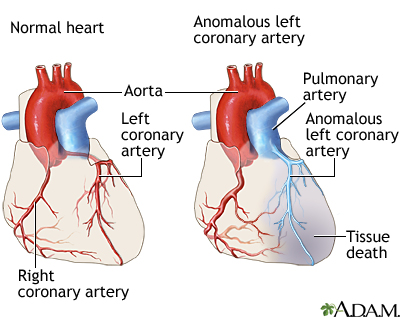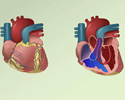Anomalous left coronary artery from the pulmonary artery
Anomalous origin of the left coronary artery arising from the pulmonary artery; ALCAPA; ALCAPA syndrome; Bland-White-Garland syndrome; Congenital heart defect - ALCAPA; Birth defect - ALCAPA
Anomalous left coronary artery from the pulmonary artery (ALCAPA) is a heart defect. The left coronary artery (LCA), which carries blood to the heart muscle, begins from the pulmonary artery instead of the aorta.
ALCAPA is present at birth (congenital) .
Present at birth (congenital)
Congenital heart disease (CHD) is a problem with the heart's structure and function that is present at birth.

Causes
ALCAPA is a problem that occurs when the baby's heart is developing early in the pregnancy. The developing blood vessel to the heart muscle does not attach correctly.
In the normal heart, the LCA originates from the aorta. It supplies oxygen-rich blood to the heart muscle on the left side of the heart as well as the mitral valve (the heart valve between the upper and lower chambers of the heart on the left side). The aorta is the major blood vessel that takes oxygen-rich blood from the heart to the rest of the body.
In children with ALCAPA, the LCA originates from the pulmonary artery. The pulmonary artery is the major blood vessel that takes oxygen-poor blood from the heart to the lungs to pick up oxygen.
When this defect occurs, blood that is lacking in oxygen is carried to the heart muscle on the left side of the heart. Therefore, the heart muscle does not get enough oxygen. The tissue begins to die due to lack of oxygen. This can cause a heart attack in the baby.
A condition known as "coronary steal" further damages the heart in babies with ALCAPA. The low blood pressure in the pulmonary artery causes blood from the abnormally connected LCA to flow back toward the pulmonary artery instead of toward the heart muscle. This results in less blood and oxygen to the heart muscle. This problem can also lead to a heart attack in a baby. Coronary steal develops over time in babies with ALCAPA if the condition is not treated early.
Symptoms
Symptoms of ALCAPA in an infant include:
- Crying or sweating during feeding
- Irritability
- Pale skin
- Poor feeding
- Rapid breathing
- Symptoms of pain or distress in the baby (often mistaken for colic)
Symptoms can appear within the first 2 months of the baby's life.
Exams and Tests
Typically, ALCAPA is diagnosed during infancy. In rare cases, this defect is not diagnosed until someone is a child or adult.
During an exam, the health care provider will likely find signs of ALCAPA, including:
-
Abnormal heart rhythm
Abnormal heart rhythm
An arrhythmia is a disorder of the heart rate (pulse) or heart rhythm. The heart can beat too fast (tachycardia), too slow (bradycardia), or irregul...
 ImageRead Article Now Book Mark Article
ImageRead Article Now Book Mark Article - Enlarged heart
-
Heart murmur
(rare)
Heart murmur
A heart murmur is a blowing, whooshing, or rasping sound heard during a heartbeat. The sound is caused by turbulent (rough) blood flow through the h...
 ImageRead Article Now Book Mark Article
ImageRead Article Now Book Mark Article - Rapid pulse
Tests that may be ordered include:
-
Echocardiogram
, which is an ultrasound that views the heart structures and blood flow inside the heart
Echocardiogram
An echocardiogram is a test that uses sound waves to create pictures of the heart. The picture and information it produces is more detailed than a s...
 ImageRead Article Now Book Mark Article
ImageRead Article Now Book Mark Article -
Electrocardiogram (
ECG
), which measures the electrical activity of the heart
ECG
An electrocardiogram (ECG) is a test that records the electrical activity of the heart.
 ImageRead Article Now Book Mark Article
ImageRead Article Now Book Mark Article -
Chest x-ray
Chest x-ray
A chest x-ray is an x-ray of the chest, lungs, heart, large arteries, ribs, and diaphragm.
 ImageRead Article Now Book Mark Article
ImageRead Article Now Book Mark Article -
MRI
, which provides a detailed image of the heart
MRI
A magnetic resonance imaging (MRI) scan is an imaging test that uses powerful magnets and radio waves to create pictures of the body. It does not us...
 ImageRead Article Now Book Mark Article
ImageRead Article Now Book Mark Article -
Cardiac catheterization
, a procedure in which a thin tube (catheter) is placed into the heart to see blood flow and take accurate measurements of blood pressure and oxygen levels
Cardiac catheterization
Cardiac catheterization involves passing a thin flexible tube (catheter) into the right or left side of the heart. The catheter is most often insert...
 ImageRead Article Now Book Mark Article
ImageRead Article Now Book Mark Article
Treatment
Surgery is needed to correct ALCAPA. Only one surgery is needed in most cases. However, the surgery will depend on the baby's condition and the size of the involved blood vessels.
Surgery
Heart surgery in children is done to repair heart defects a child is born with (congenital heart defects) and heart diseases a child gets after birth...

If the heart muscle supporting the mitral valve is seriously damaged from decreased oxygen, the baby may also need surgery to repair or replace the valve. The mitral valve controls blood flow between the chambers on the left side of the heart.
A heart transplant can be done in case the baby's heart is severely damaged due to lack of oxygen.
Heart transplant
A heart transplant is surgery to remove a damaged or diseased heart and replace it with a healthy donor heart.

Medicines used include:
- Water pills (diuretics )
- Drugs that make the heart muscle pump harder (inotropic agents)
- Drugs that lower the workload on the heart (beta-blockers, ACE inhibitors)
Outlook (Prognosis)
Without treatment, most babies do not survive their first year. Children who do survive without treatment may have serious heart problems. Babies with this problem who aren't treated could die suddenly during the following years.
With early treatment such as surgery, most babies do well and can expect a normal life. Routine follow-ups with a heart specialist (cardiologist) will be needed.
Possible Complications
Complications of ALCAPA include:
- Heart attack
- Heart failure
- Heart rhythm problems
- Permanent damage to the heart
When to Contact a Medical Professional
Call your provider if your baby:
- Is breathing rapidly
- Looks very pale
- Seems distressed and cries often
References
Brizard CP. Congenital anomalies of mitral valve. In: Sellke FW, del Nido PJ, Swanson SJ, eds. Sabiston and Spencer Surgery of the Chest . 9th ed. Philadelphia, PA: Elsevier; 2016:chap 127.
Brothers JA, Gaynor JW. Surgery for congenital anomalies of the coronary arteries. In: Sellke FW, del Nido PJ, Swanson SJ, eds. Sabiston and Spencer Surgery of the Chest . 9th ed. Philadelphia, PA: Elsevier; 2016:chap 124.
Kliegman RM, Stanton BF, St. Geme JW, Schor NF. Other congenital heart and vascular malformations. In: Kliegman RM, Stanton BF, St. Geme JW, Schor NF, eds. Nelson Textbook of Pediatrics . 20th ed. Philadelphia, PA: Elsevier; 2016:chap 432.
-
Congenital heart defect overview
Animation
-
Anomalous left coronary artery - illustration
Anomalous left coronary artery is a heart defect in which the left coronary artery, which usually carries blood to a large portion of the heart muscle, does not form correctly. This causes the heart to not receive enough oxygen for it to pump correctly. This heart defect is present at birth and happens during the development of the baby's heart and vessels.
Anomalous left coronary artery
illustration
-
Anomalous left coronary artery - illustration
Anomalous left coronary artery is a heart defect in which the left coronary artery, which usually carries blood to a large portion of the heart muscle, does not form correctly. This causes the heart to not receive enough oxygen for it to pump correctly. This heart defect is present at birth and happens during the development of the baby's heart and vessels.
Anomalous left coronary artery
illustration
Review Date: 5/6/2016
Reviewed By: Scott I. Aydin, MD, Assistant Professor of Pediatrics, Albert Einstein College of Medicine, Division of Pediatric Cardiology and Critical Care Medicine, The Children's Hospital at Montefiore, Bronx, NY. Review provided by VeriMed Healthcare Network. Also reviewed by David Zieve, MD, MHA, Isla Ogilvie, PhD, and the A.D.A.M. Editorial team.



